
Do you feel like your emotions are running the show and you’re being pulled along behind them? Do you sometimes think – if only I could learn how to control my emotions I wouldn’t have to feel this way.
I came across a note in my Yoga Sutra journal recently and felt it was a sign I should be answering this question today. I’d written:
“The less reactive we become to feeling, the more power we have over what we feel.”
It was entered as an afterthought over three years ago, I’m not sure if it was my own spark of insight or a quote from someone during my Yoga Teacher Training. If you remember saying this – please let me know so I can give you appropriate credit!
Controlling Emotions ISN’T About Banishing Them
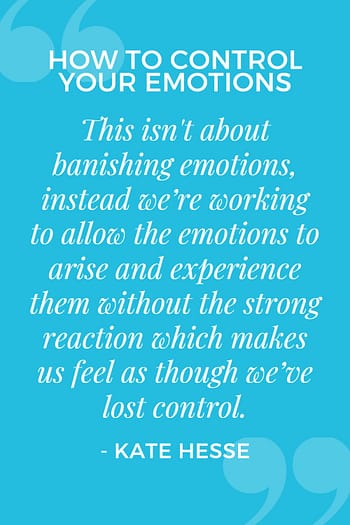 Today’s questioner asks about controlling their emotions. And while I’ll be offering a number of tools and techniques to help you take control of your emotional state, I want to be clear that we’re not talking about banishing emotions. Instead we’re working to allow the emotions to arise and to experience them without the strong reaction which makes us feel as though we’ve lost control.
Today’s questioner asks about controlling their emotions. And while I’ll be offering a number of tools and techniques to help you take control of your emotional state, I want to be clear that we’re not talking about banishing emotions. Instead we’re working to allow the emotions to arise and to experience them without the strong reaction which makes us feel as though we’ve lost control.
In keeping with what’s becoming a running theme – so many of these things are so much easier to say than to do.
It’s easy to say – just stop reacting to your emotions. But that’s a skill we need to develop – not one we have simply because we decide to have it.
I’m going to cover several different tools, techniques, and mindset shifts in this episode, so I’ve put together a checklist with everything I’m covering to help you stop feeling so out of control. Don’t worry about taking notes as you listen to this episode or read through this post – I’ve done it for you! You can get your copy using the form below.
In this post I’m offering advice on how to respond in a triage situation – once your emotions are already running the show.
To be proactive in taking control of your emotional wellbeing, you want to work on building your resilience. A great place to start is with self-care and I’ve included everything you need to build a consistent, sufficient, and sustainable Self-Care routine that works for you and your life in my free Self-Care Toolkit.
Calming Your Nervous System
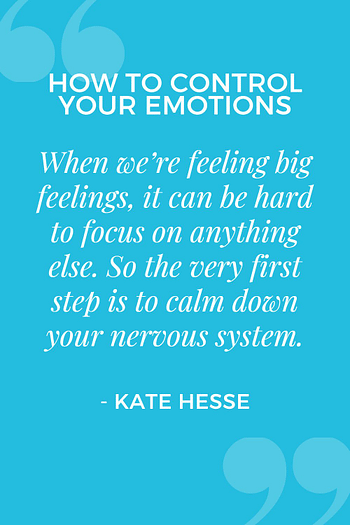 When we’re feeling big feelings, it can be hard to focus on anything else. So the very first step is to calm down your nervous system.
When we’re feeling big feelings, it can be hard to focus on anything else. So the very first step is to calm down your nervous system.
We’ve covered the audible exhale in several previous episodes – and it would be a great tool to use in this situation.
But since we’ve already talked about it a few times, today I want to share another tool to help you shift out of the sympathetic nervous system – your fight, flight, or freeze response, and into the parasympathetic nervous system – your rest and digest state.
In Episode 8 I talked about why making this shift is so important – it helps to calm your body and mind and allows you to bring the logic and reasoning centers in your brain back on-line.
Imagine your emotions are driving a car recklessly and out of control, calming your nervous system is like adding a brake to the passenger side of the car – just like driver’s ed. Giving you a chance to slow the speeding car down a little.
The Mindful Moment
A great way to slow down your runaway emotions is to bring your attention fully back into the present moment and I love to use the Mindful Moment technique to do this. Just like the audible exhale it only takes a minute or two, but in that short time it can bring about a powerful mental and emotional shift.
The Mindful Moment is simply the practice of noticing the world around you with all five sense. You can pick a specific object or focus on a general area. I love doing this exercise with a cup of tea, a piece of chocolate, or while looking out into my backyard.
Take a moment and focus in on what you’ve selected, and notice:
- What does it smell like?
- What does it sound like?
- How does if feel?
- How does it taste (or what taste can you notice in your mouth while observing it if it’s not something you actually want to eat)?
- And what does it look like?
As you notice, get incredible specific in your description. If you’re using tea, instead of it feeling “hot”, you might describe it to yourself as “being at the perfect temperature to take a sip while still being hot enough to fully warm your insides”.
Work through each sense in turn.
And once you’ve finished, check back in and see if you’ve been able to gain a little more perspective, distance, or control over your emotional state.
You Are Not Your Emotions
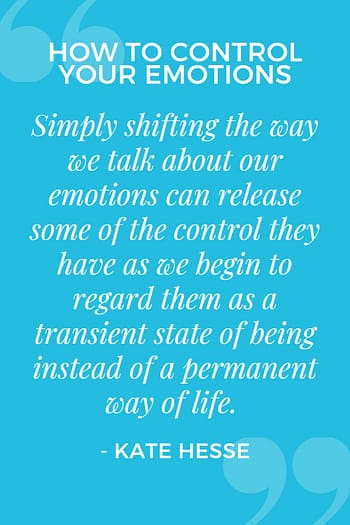 Take a moment and think about how you talk about your emotions. When we say things like “I’m sad”, we’ve turned the emotion into a part of our identity.
Take a moment and think about how you talk about your emotions. When we say things like “I’m sad”, we’ve turned the emotion into a part of our identity.
However, if we say “I’m feeling sad”, instead, we’ve identified the emotion as a temporary state we’re experiencing.
While the addition of that one word might seem small, the impact is huge. Instead of feeling like sadness is part of our personality, we’ve turned it into something that will pass.
Think back on your life – over the years you’ve felt countless emotions. They’ve come and gone. You can probably remember being happy, scared, excited, sad, frustrated, elated, and so much more. The current emotions you’re feeling are no different. And it’s powerful to use words that help reflect that reality.
Simply shifting the way we talk about our emotions can help to release some of the control they seem to have as we begin to regard them as a transient state of being instead of a permanent way of life.
Instinct vs. Intuition
Often when our emotions take control, we’re running on autopilot. This happens to me a lot when I’m overtired or over hungry. My body is solely focused on getting my most pressing physical needs met.
And in order to do this, we begin to run based on instinct instead of intuition.
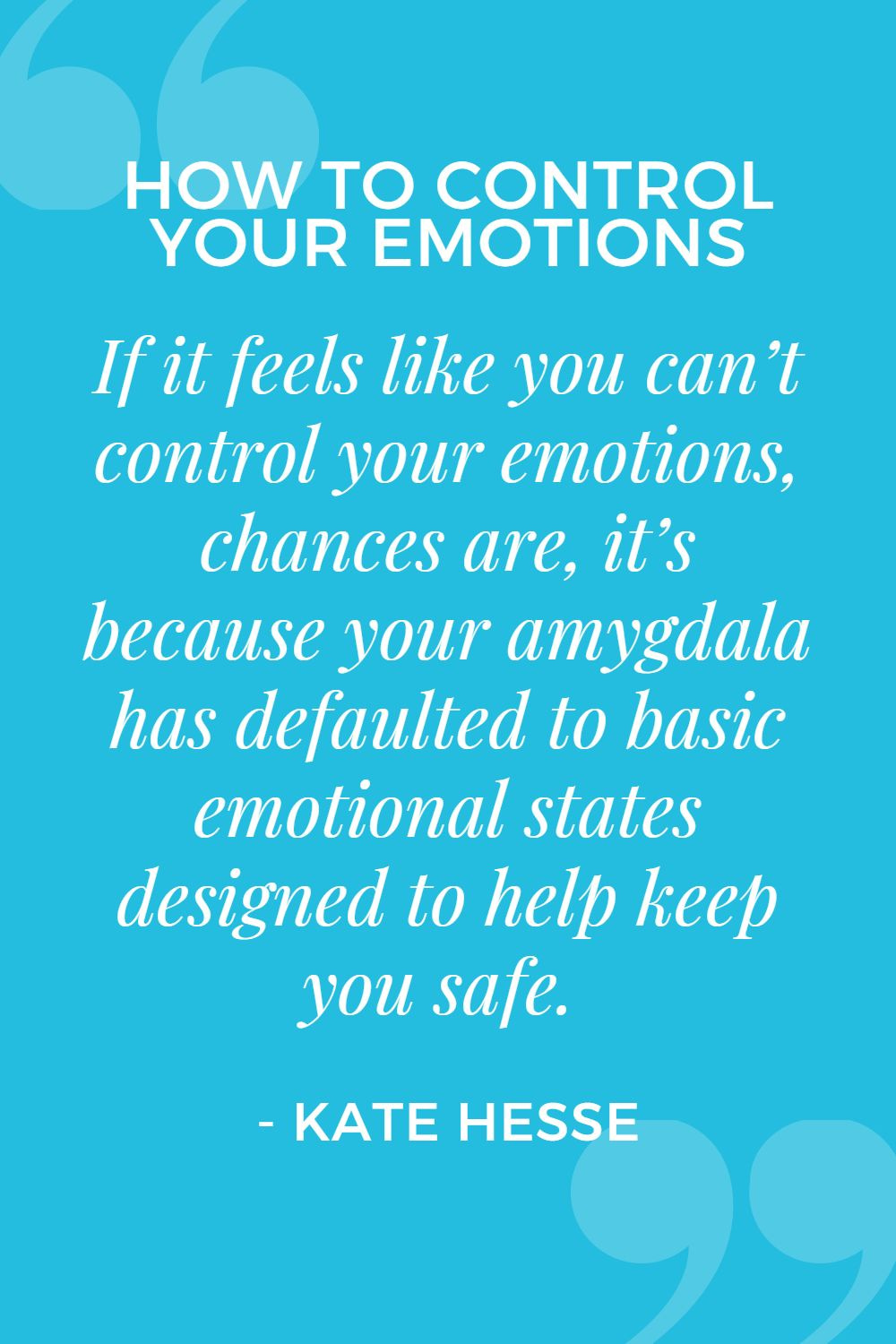 Our instinct is driven by the amygdala. You might remember me mentioning in the past the amygdala is the fear center of our brain. It works hard to keep us safe by seeking, and preparing to respond to, danger.
Our instinct is driven by the amygdala. You might remember me mentioning in the past the amygdala is the fear center of our brain. It works hard to keep us safe by seeking, and preparing to respond to, danger.
Our intuition on the other hand is a deep knowing. It’s separate from our fear and it’s sole purpose is to help us live our best lives. If you missed Episode 7 of the podcast, I talked all about the science behind your intuition.
Think about your brain like a computer set up to dual boot – you can run two different operating systems on it – switching back and forth to the one you need at any given time. When the amygdala is the operating system in charge, it’s running programs in the background that are informed by things like your confirmation and negativity biases – we talked about those last week in Episode 10.
What this all means is when you’re in survival mode, your brain tends to run emotions on a loop. So if it feels like you can’t control your emotions, chances are, it’s because your amygdala has defaulted to basic emotional states designed to help keep you safe.
Why Calming the Nervous System Matters
In order to begin to take back conscious control of your emotions, you need to switch to the other operating system and begin to run on intuition instead of instinct.
Our intuition is often drowned out by the voice of our instinct, but when we learn to distinguish between the two, we can take steps to calm our instinct while tuning into our intuition.
A great way to help you shift out of instinctive reaction and into quiet intuition is to calm your nervous system – again go back to the audible exhale, the mindful moment, or any other technique you love to help you shift out of the sympathetic and into the parasympathetic nervous system state. Out of your fight, flight, or freeze response, and into rest and digest.
Getting Curious
Another fantastic tool for helping boot up the intuition operating system is to get curious. Start by discovering the distinct voice of your intuition and tuning into the messages it offers.
Then ask your intuition – why am I experiencing this emotion? What lesson does it have to offer?
Adam is deliberate in choosing his words. Sometimes I get impatient and interrupt him. It’s a habit neither of us are particularly fond of. After I interrupt him, I often feel guilty. But when I get curious, I recognize the guilt is nudging me to remember to be a little more patient the next time he pauses to choose his words. Understanding the lesson helps to release the regret and rumination.
Curiosity Isn’t About Assigning Value
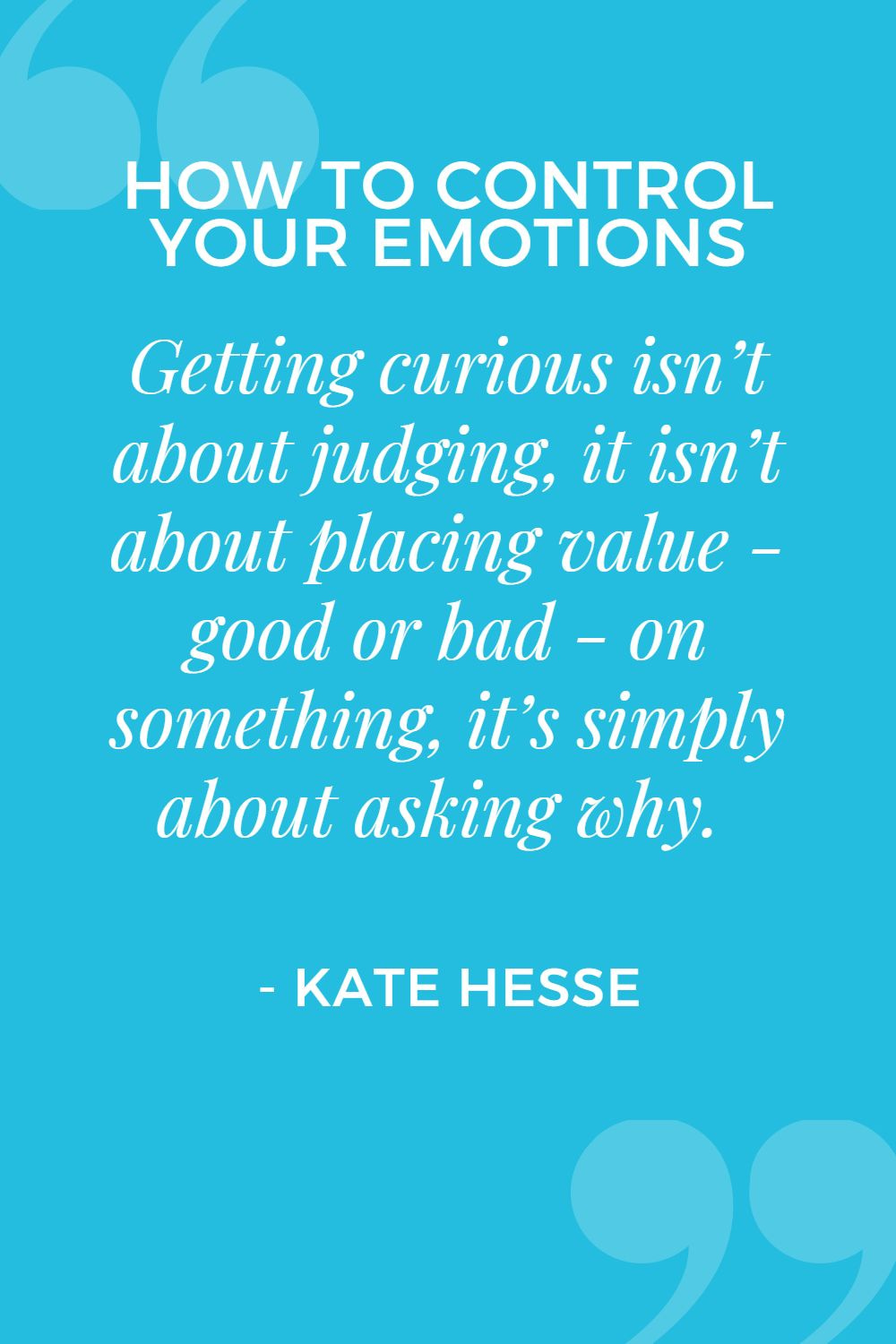 Getting curious isn’t about judging, it isn’t about placing value – good or bad – on something, it’s simply about asking why.
Getting curious isn’t about judging, it isn’t about placing value – good or bad – on something, it’s simply about asking why.
I love how curious little kids are. They’ll ask you why a million times trying to understand why you’ve said or done something – or why the world is the way it is.
Consider tapping into your inner little kid and with pure innocent curiosity start asking yourself why – why are you experiencing this emotion? Why now? Why so persistently? And what can you shift and change to allow the emotion to release?
If you need more help connecting to and working with your intuition, check out my Intuition 101 Course, and bonus – you’ll get 25% off the course with code PODCAST.
Identifying and Questioning the Story Behind the Emotion
If you’re finding the answer to getting curious keeps popping up as “because”, it’s time to start questioning the story behind the emotion. It might be simply because. Or because so and so said so. Perhaps because that’s the way I was taught to respond. Maybe because that’s what good, smart, nice girls do. Or anything else along those lines!
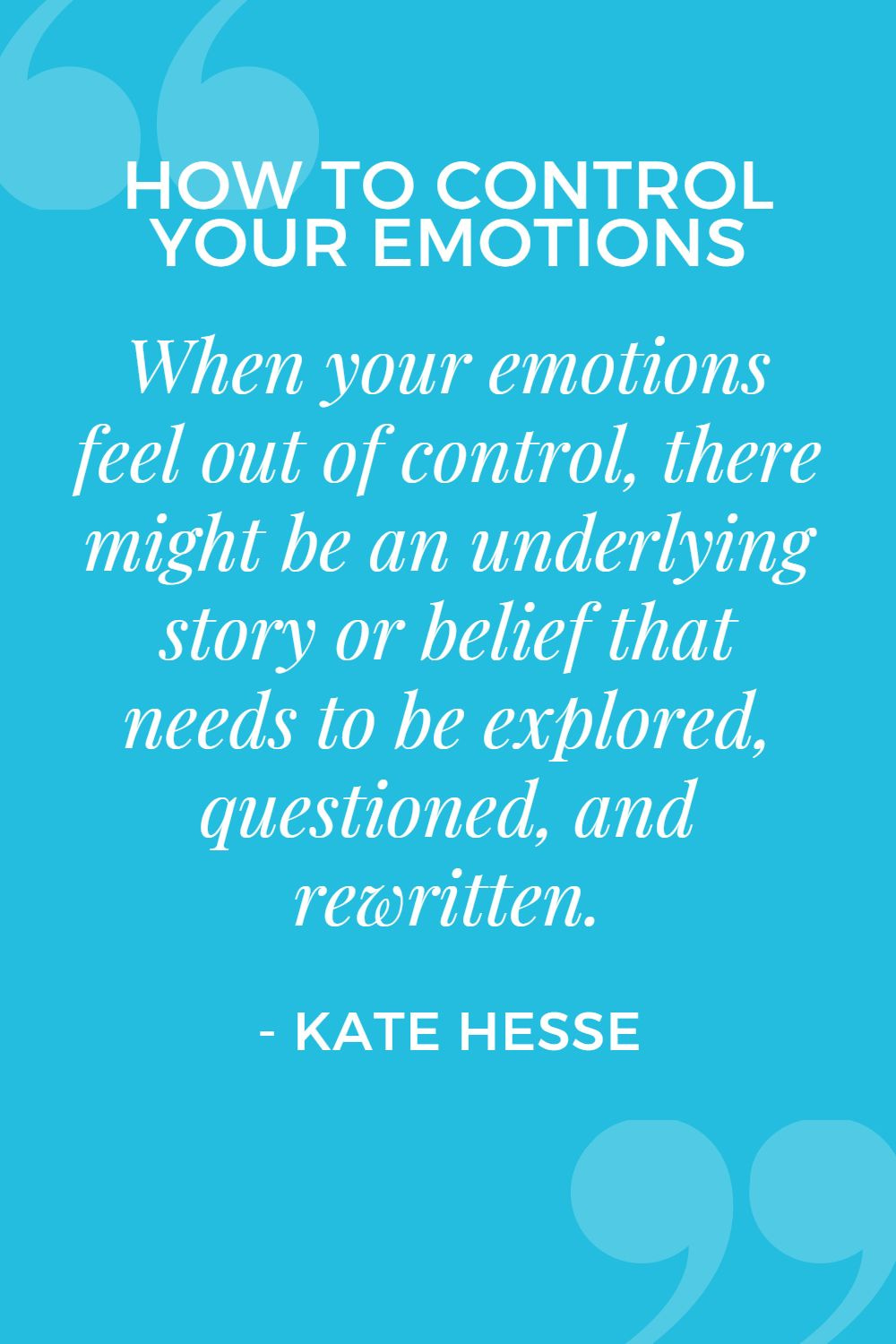 You might have heard before if something is true to you it will feel good. It’s only the things you don’t at your core believe that feel yucky.
You might have heard before if something is true to you it will feel good. It’s only the things you don’t at your core believe that feel yucky.
Those yucky feelings are the result of you waging war in your own mind and body. The result of you trying to force yourself to get on board with something you don’t actually believe in, or agree with, at a deep core level.
I’m not sure anyone’s ever complained about being stuck feeling happiness, joy, or ease. It’s feelings like frustration, disappointment, sadness, and anger we want to get away from, and so when your emotions feel out of control, it’s a great sign there might be an underlying story that needs to be explored.
Continue the theme of getting curious.
Ask yourself if you truly believe the story that seems to be behind this emotion. Can you find evidence or have you had experiences that demonstrate it isn’t necessarily true? Can you imagine yourself in a world in which it isn’t true? Picture living in that world in which it isn’t true – how does that feel?
Again, it might not be as simple as deciding you no longer believe in a deeply ingrained story, but questioning the belief is a powerful tool in again stepping on the break in the car and slowing down the runaway emotions.
Honoring the Emotions
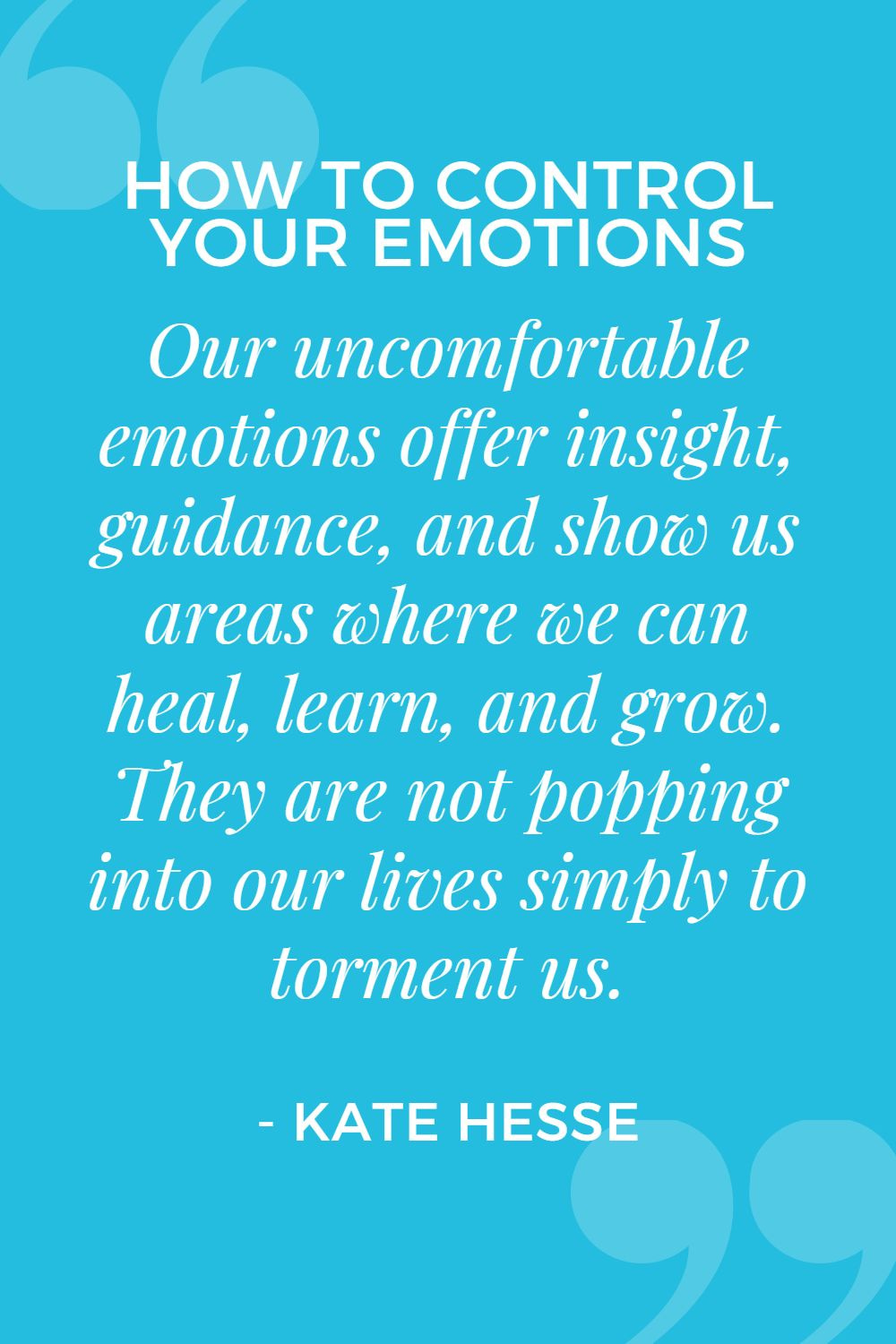 You might be starting to realize that even the uncomfortable emotions are showing up for a reason. They’re offering insight, guidance, and showing us areas where we can heal, learn, and grow. They are not popping into our lives simply to torment us.
You might be starting to realize that even the uncomfortable emotions are showing up for a reason. They’re offering insight, guidance, and showing us areas where we can heal, learn, and grow. They are not popping into our lives simply to torment us.
When we try to shove those emotions down into a dark corner where we don’t have to think about or listen to them, they start shouting louder to get our attention. They’re showing up for a purpose and if we continue to ignore them they will continue to shout louder trying to make sure we know why they are there!
So another important step in taking control of your emotions is to recognize and honor them. If you’re feeling sad, thank the sadness for showing up to help you with whatever you’ve identified as the why behind it. Or you can simply thank the sadness for allowing you to have a perspective on how sweet joy can be.
Sometimes the emotions simply need to be seen and honored in order for them to begin to slow down, and move to the side, still present, but not dominating your thoughts and feelings. And when you pair that acknowledgment with action taken on the message they came to share, that’s a powerful step away from reactivity.
Noticing the Similarity Between Shadow and Light Emotions
Imagine your heart rate accelerates, your breathing speeds up, you feel restless, and your stomach is turning somersaults.
What emotion are you feeling?
I’m guessing you might have answered one of two emotions – either excited or anxious. If you picked one of these two, take a minute and think if these physical experiences could also match the emotion you didn’t choose.
Again, that’s an accelerated heart rate, rapid breathing, a feeling of restlessness, and your stomach turning somersaults.
I’ve been playing with anxiety and excitement lately. One of the emotions that pops up for me a lot is anxiety. But when it arises, I’ve been getting curious and asking myself – is this really anxiety, or could I simply be feeling excitement about something? They both feel really similar in my body. Could I be mistaking excitement for anxiety?
And the beauty of asking these questions is I get to consciously step into the driver’s seat and decide if I’m feeling anxiety or if I’m feeling excitement.
Bringing Conscious Attention to What You’re Experiencing
Often the emotions we’d rather not experience are referred to as shadow emotions – they’re the ones we try to push into the dark corners and ignore. The emotions we’d like to experience are often called light emotions – they’re the ones we want to put out on full display.
Most things in life have both a shadow and a light side and our emotions are no different.
Consider the shadow emotions you tend to experience – anything you’d rather not be experiencing and wish you banish with a magic wand. Now consider what the light side of that emotion might be – what other emotion might feel the same in your body – a few examples are: anxiety and excitement, anger and courage, or frustration and anticipation.
Being able to reframe the physical manifestations of what we’re experiencing is another great way to begin to slow down the emotional reactivity and gently press your foot on the break.
Taking Control of Your Emotions
So the next time it feels like your emotions are running the show, start by calming your nervous system with the audible exhale, mindful moment, or any other technique that works for you.
Next, acknowledge the emotion, and get curious – what lesson is it trying to offer you? How can you take action on that lesson? And ask yourself if perhaps you can reframe the emotion to see the flip side of the coin.
We’ve covered a lot of tools and techniques in this episode – don’t forget I’ve put it all together for you in a free checklist you can download using the form below. Use the checklist to pick the tools, techniques, or mindset shifts that resonate most strongly with you and the current situation.
Remember – living your best life isn’t about changing your life – it’s about changing the way you show up for your life!
Show Notes
Additional Resources
Get the Free Self-Care Toolkit
Podcast Episode 7 – The Science Behind Your Intuition
Learn more and register for my Intuition 101 Course – SAVE 25% with code PODCAST
Submit your question to be featured on a future episode.
Related
2 thoughts on “How to Control Your Emotions”
Leave a Reply Cancel reply
This site uses Akismet to reduce spam. Learn how your comment data is processed.
[…] is, what it isn’t, and why it matters. Let’s get into how you can practice grounding. In Episode 11 we talked about the mindful moment – surprise – it’s a powerful grounding technique. […]
[…] to take action, use whatever self-care tools and techniques work for you – things like the mindful moment, the audible exhale, grounding visualizations, or a round or two of tapping can be powerful in […]